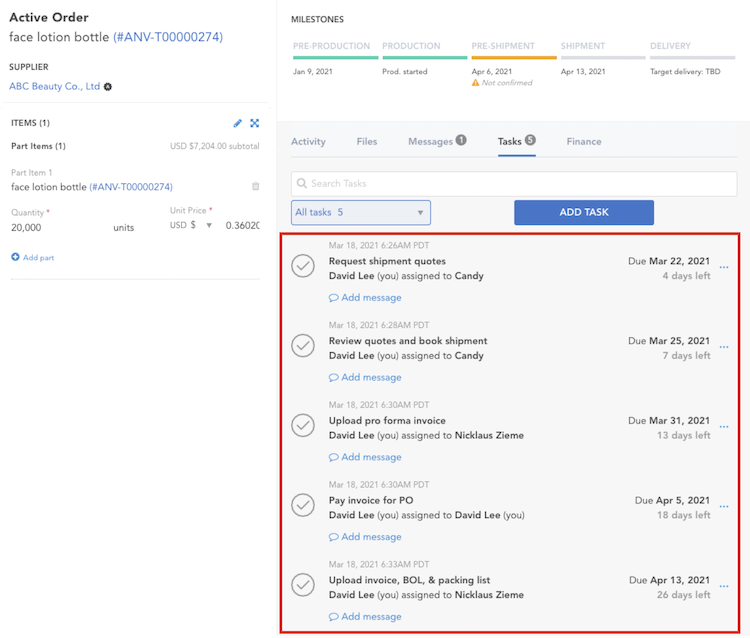What good is placing an order without a plan to receive it? While it is important to ensure production kicks off and stays on track, it is equally important to establish a schedule for shipping your components or finished goods. When you streamline the process, you will save time and limited unexpected issues further downstream in your supply chain. Your customers must receive their products!
Be sure you collaborate with your suppliers on these critical actions.
1. Choose the Mode of Transportation
Hopefully with good planning, you are able to mitigate and default to standard shipping lanes and cheaper freight options without sacrificing your ending inventory numbers. Based upon when and how many items you need will dictate if it is air or ocean for an international supplier, a dedicated truck, regular LTL or FTL service, air or even rail for those domestic suppliers. If you want to stagger your shipment dates, ship a partial, ship to different final destinations, it is important to line those up with correct mode as the paperwork needed will all be different and must be precise.
2. Select the Forwarder/Carrier
Dependent on how large your logistics team and the number of shipments you have per year will determine if you interact with a freight forwarder or directly with a carrier. For simplicity purposes, you will most likely interact with a forwarder as they will handle the communication with your shipper and should streamline the paperwork and/or customs workflow. Initially, it makes sense to RFQ your services to multiple forwarders but overtime and dependent on volume of shipments, you can centralize this. Your forwarders will be able to get better buying power if your shipment volumes increase and will be a key partner of yours in optimizing shipment lanes and processing information.
To quote these out, you will need the packing list, a document generated and provided to you by your supplier. A draft packing list will be sufficient to get a quotation for your freight, but later down the line, you will need to request an finalized packing list for the actual shipment. The freight forwarder is also going to ask for the incoterms. Incoterms specify who (seller or buyer) is responsible for paying for and managing the shipment plus the additional logistical activities that take place like insurance, documentation and if needed customs clearance. The most commonly used incoterms for modes of transportation are Ex-Works (EXW), in which the seller bears the least amount of responsibility of ensuring the goods are available for pick-up at location. FOB, (Free on Board), the seller bears the responsibility to load the goods onto the ocean vessel and the near equivalent for air is FCA (Free Carrier)
When you analyze the quotes, decide if you are optimizing your shipment for speed or for cost and consider the following metrics:
- Rate: How much is the shipment going to cost? How does this cost impact my COGS?
- Ancillary Fees: What ancillary charges are quoted for each carrier and how will this impact your bottom line?
- Timeline: Will goods arrive on time? Has the carrier optimized the route for this shipment?
Depending on where the goods are supposed to go and when they are needed, you can plan backwards from the deadline date, assess the various options, and select the carrier that best fits with your business goals.
3. Request Final Documents from Supplier
When your order is completed and you determine your quantity for shipment, mode of transportation you need to request the following documents.
- Packing list
- Commercial invoice
The packing list and commercial invoice need to match each other for importing and exporting. If shipping via ocean, the final destination is not as important now because you can change the end destination address when it is sailing or even upto arrival at port. However, you will need to have the determined port figured out prior to it leaving the warehouse. If importing into the United States, you will need to know the HS (Harmonized System) code to assist customs. These should be placed on the packing list per item. A glass roller bottle shipped unassembled is going to have three different HS codes and product descriptions, which means the commercial invoice also needs to have three line items to match the part numbers and quantity staged for importing This isn’t a document but in your first import, the importer will either need to set-up an annual bond or pay a bond per shipment. If your forwarder doesn’t offer a customs clearance broker, you will need to establish one.
Once your packing list and commercial invoices are matched, which is one step portion of ensuring a proper three-way match and based upon the incoterms, a Bill of Lading (BOL) wll be issued. The BOL is a document issued by the carrier to the supplier of goods as a contract of the carriage of the goods. It is the contract or receipt that shows proof that the goods were accepted between the two parties.
Besides those three documents, it is good to confirm the following checklist for your internal records but also with your supplier, freight forwarder and ship-to location partner:
- Responsible Parties
- Place of Origin
- Place of Port
- Shipping Marks
- Final Destination
- Number of Packages
- Number of Pallets
- Contents of the Packages
- HS Code
- Weight and Volume
- Delivery Hours
- Tracking numbers
- Container numbers
- Vessel numbers
4. Automate This Checklist for Every Order
Since every purchase order will require a shipment, you can make this process repeatable through a set of tasks. Platforms like Anvyl can be set to automatically coordinate assigning all of these required tasks to the correct parties, allowing you to get through the day more efficiently.
Here’s an example below of how to set-up a list of tasks prior to booking your shipment:
Learn More
To learn more about how to coordinate shipments through automation and standardizing your process, connect with a specialist today.




